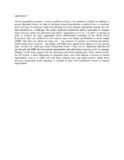To plant or protect: evaluating forest recovery dynamics under natural and aided regeneration in Western Kenya

View/
Date
2013-08Author
Otuoma, John
Ongugo, Paul
Kemboi, Damaris
Mairura, Franklin
Akinyi, Fiona
Language
enMetadata
Show full item recordAbstract
Forest degradation remains a serious problem in Kenya, but opinion is divided on whether to protect
degraded forests in order to facilitate natural regeneration or plant th
em to accelerate forest recovery. In
situations where tree planting has been adopted, appropriate spacing has also been identified as a
challenge. We used a replicated randomized block experiment to compare forest recovery under site
protection and aided r
egeneration at 0.3
m, 1
m and 5
m spacing in order to identify the most appropriate
forest rehabilitation technique in the Nandi Forest Ecosystem. Data was collected on
tree species type,
tree height and diameter at breast height (DBH). The data was analyz
ed using
two
-
way analysis of
variance in Genstat procedures. Under aided forest
recovery
, tree height and DBH were significantly
higher at 0.3 m spacing than 1
m and 5
m, which gave fairly comparable results.
T
here was no significant
difference in tree hei
ght and DBH between natural regeneration and aided forest recovery at 0.3 m
spacing. Findings of the study
suggest that site protection and dense planting give fairly similar results,
but the former is more appropriate in degraded forest sites with adequat
e sources of natural regeneration,
such as
a viable
soil seed bank, remnant trees and stump sprouts. Aided forest recovery, particularly
dense planting, is suitable in sites with insufficient sources of natural regeneration
Citation
Otuoma, John., Ongugo, Paul., Kemboi, Damaris., Mairura, Franklin and Akinyi, Fiona (2013). To plant or protect: evaluating forest recovery dynamics under natural and aided regeneration in Western Kenya. First international research and innovation conference, 28-30 August Pp. 6-18. Safari Park HotelNairobi, KenyaPublisher
University of Nairobi
